|
Advantech TREK-550/TREK-303H
Rugged in-vehicle computing/display system for mobile resource management applications
(by Conrad H. Blickenstorfer, photography by Carol Cotton)
What is Mobile Resource Management?
Computers and electronic communication have changed almost every aspect of our personal lives over the past 20-30 years but, if anything, the changes have been even larger in commerce and industry. Take transportation, for example, where automated fleet management and mobile resource management are taking center stage in real time tracking, dispatching, and increasing driver safety and asset utilization, all the while reducing errors, unauthorized vehicle use, fuel usage and overall costs.
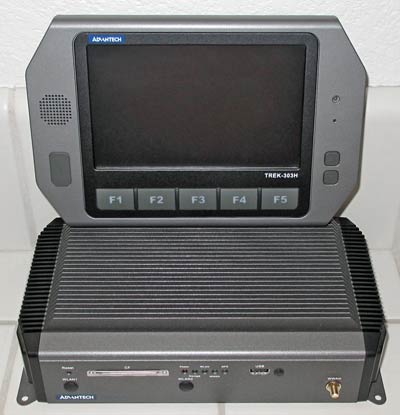 This is made possible by a combination of rugged, compact computing equipment that can handle the punishment of vehicular use; integration with GPS functionality that enables location-based services; and increasing integration of computers into the vehicle itself. But how does it all work? This is made possible by a combination of rugged, compact computing equipment that can handle the punishment of vehicular use; integration with GPS functionality that enables location-based services; and increasing integration of computers into the vehicle itself. But how does it all work?
Imagine a small, rugged system unit that can be located anywhere in the vehicle, out of the way. That system unit is connected to a vehicle display that can be operated both via touchscreen and via programmable function keys.
The system unit can be used to communicate via standard COM ports with such legacy peripherals as printers or barcode readers. It can also communicate with the vehicle directly through a CAN-bus. CAN stands for Controller Area Network and is a vehicle bus standard that lets various systems and devices communicate with one another. This way, the computer might access door locks, temperature controls, alarms, diagnostics, etc.
Finally, the computer could also access numerous sensors informing about temperatures (crucial in refrigerated trucks), pressures, and all sorts of other variables. All of this information could be processed and used for fleet management and mobile resource management purposes.
Now add GPS and advanced data communication technology, and you have all the components for very sophisticated management systems that move data and information back and forth between vehicles and their dispatch or home base. The opportunities are almost endless.
This is what Advantech had in mind when they introduced the TREK-550 in-vehicle computer and its accompanying TREK-303H smart vehicle display.
The Advantech TREK-303H Smart Display
Advantech has been using a special, optimized design for in-vehicle displays and computers for a while now. The same basic form factor used in the TREK-303H is also used in the TREK-743, which is actually both a display and a computer. The TREK-303, however, is meant to be used as part of a vehicle display system that also includes one of Advantech's suitable in-vehicle industrial computers, in this case the TREK-550.
As is, the TREK-303 touch panel, which measures 9.5 x 6.3 inches and is 1.6 inches thick, is compact enough for tight spaces, yet the display is large enough to be useful and easy to use in all sorts of fleet management and dispatch applications. It also has a tough but lightweight housing that is compatible with RAM mounting solutions so that customers can easily install it according to their requirements.
Below you can see the Advantech TREK-303 smart display (here the lower-res version running Winodws CE) from the front and all sides.
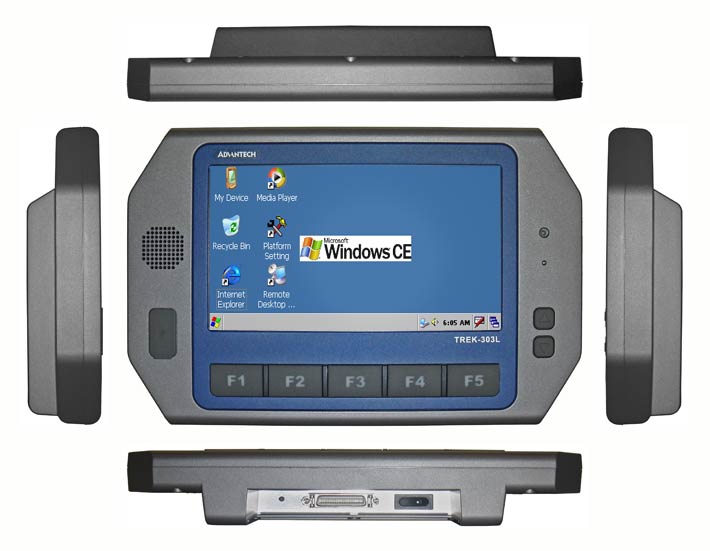
Vehicle computers and displays are often subjected to very wide temperature ranges, and so Advantech made sure the TREK-303 meets the requirements for automotive grade working temperatures with an exceptionally wide -22 to 158 degrees Fahrenheit (-30 ~ 70 degrees Celsius) operating temperature range. 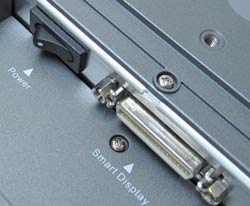 And while most TREK-303 displays will be mounted inside vehicles away from rain or splashing, the TREK-303 does carry an IP43 rating (protected against solids larger than 1 mm in diameter and against water spray to the front) for the whole device, with everything but the I/O ports actually sealed to IP54 standards (protected against dust and also against water spray from all directions). The unit has also been vibration-tested in accordance with MIL-STD-810G, SAE J1455 4.9.4.2. And while most TREK-303 displays will be mounted inside vehicles away from rain or splashing, the TREK-303 does carry an IP43 rating (protected against solids larger than 1 mm in diameter and against water spray to the front) for the whole device, with everything but the I/O ports actually sealed to IP54 standards (protected against dust and also against water spray from all directions). The unit has also been vibration-tested in accordance with MIL-STD-810G, SAE J1455 4.9.4.2.
The TREK-303 was designed from the start with drivers in mind. For example, powering up the system or waking up can easily be done from a switch in the back of the TREK-303 (see picture to the right); there is no need to go through software and complex sequences. For night driving, the display has an auto-detecting light sensor to automatically adjust brightness for optimal viewing.
But now on to the second part of this system, the Advantech TREK-550 in-vehicle computer.
The Advantech TREK-550 In-Vehicle Computer
If the TREK-550 looks a lot like one of Advantech's industrial PCs, it's because in many respects that is what it is. Many of the same requirements apply to a vehicle computer as do to an industrial PC. It must be compact for easy placement. It must be rugged enough to withstand abuse. It must be reliable enough to operate 24/7/365 with minimal maintenance and maximum up-time. It must provide targeted performance, generate a minimum of heat and noise, and support the standards and connectivity required for the task.
"Targeted" performance means as much as is required, no more and no less. With the TREK-550, Advantech provides just that. The system is powered by an Intel Atom XL Z510PT running at 1.1GHz, and optionally with the slightly faster 1.3GHz Z520PT. That's enough to allow the TREK-550 to run a variety of operating platforms, including Windows CE 6.0, Microsoft's equally unassuming workhorse mini-OS that's been used for embedded industrial applications for almost 15 years; Windows XP Embedded, or even Ubuntu Linux. Everything is designed to do the job, no more and no less. Systems such as these are not burdened with the unneeded complexity of a full OS such as Windows 7.
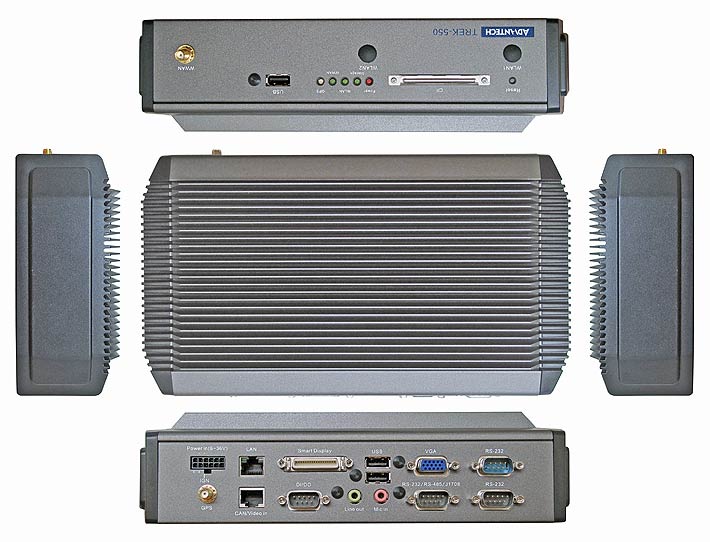
As you can see above, the TREK-550, which measures just 10.35 x 5.9 x 2.75 inches and weighs 4.4 pounds, is a very compact unit. It has a gray alluminum chassis, black plastic end caps, and an integrated a finned aluminum heatsink on top. For access to the interior of the unit, remove a few small Philips head screws. The inside is neat and clean and well designed, as we'd come to expect from Advantech. The motherboard measures roughly 200 x 140 mm and has all of its external ports mounted right on the board. Note the CF Card slot on the bottom. You can also see is the small Wavwecom WMP100 WWAN board that is mounted to separate I/O board of the unit that also includes a SIM card caddy for GSM-based data communications.
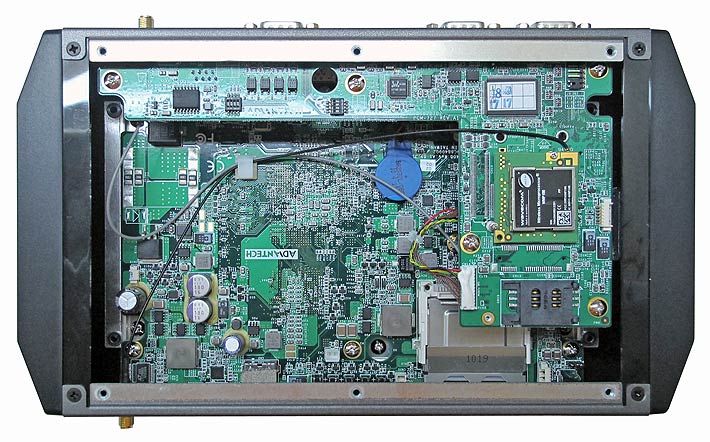
For I/O, the TREK-550 offers ample onboard connectivity for just about any task.
On the front, the TREK-550 has:
- USB Host (standard connector)
- CF Card slot
- Reset
- WWAN antenna port
- 2 WLAN antenna ports
On the back side are:
- RCA Mic in
- RCA Line out
- 1 DB9 RS232/RS485/J1708 serial port
- 2 DB9 RS232 serial ports
- 1 DB9 DI/DO port
- 1 VGA port
- 1 CAN port
- Smart Display port
- GPS antenna port
But what about applications that do not require full Windows XP or even Windows Embedded? For those, Advantech offers a very similar setup with the TREK-510 on the computer side, and a lower-res version of the TREK-303 smart display. And for an overall look at Advantech TREK hardware see here.
Additional thoughts about TREK-based Mobile Resource Management systems
As an early adopter of GPS technology (mid 1990s) and also having dabbled in OBD-II (see The Computer in Your Car), which stands for "OnBoard Diagnostics," the increasing use of computers in vehicles is no surprise to me, nor is the increasing sophistication and innovation of such uses. In fact, we're probably seeing just the beginning.
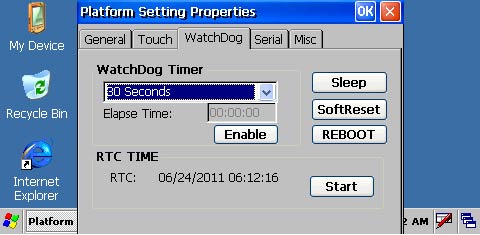 It is hard to overestimate the potential benefit of mobile resource management. Intelligent fleet monitoring can revolutionize the way a business is run. In addition to basics like theft protection, dispatchers and fleet management know at any time where their vehicles are, what routes they have run, what the odometer reading is, and whether they are being used according to plan and policy. It is hard to overestimate the potential benefit of mobile resource management. Intelligent fleet monitoring can revolutionize the way a business is run. In addition to basics like theft protection, dispatchers and fleet management know at any time where their vehicles are, what routes they have run, what the odometer reading is, and whether they are being used according to plan and policy.
An advanced system may not only provide vehicle location on a map, geofences, remote alarms and door unlocking, but also detailed history reports that can show hourly usage, violations, speeding, or many other parameters. (The picture above shows one of many utilities Advantech makes available with their TREK systems, this one a Windows CE app.)
All sorts of special sensors can be used to retrieve information from the OBD-II onboard diagnostics system that has been mandatory in vehicles sold in the United States since 1996. OBD-II tracks dozens of vehicle functions, and that data could be used to provide fuel efficiency data, warn of potential vehicle and component failures or manage maintenance requirements. And the industry is just beginning to meld the up to now completely separate world of vehicle computers, generally known as ECUs (Engine Control Units), with computers and communication systems as we know them.
If all this sounds enormously complicated, it is and it's not. Installation of a GPS vehicle tracking system is inherently no more difficult than that of a car audio system. Setting up web-based tracking reports is simple as well, and can be done both for individual vehicles as well as for small and large fleets.
How much does it cost? That depends on the type and system as well as the software it comes with. Developers and systems integrators may use the rugged Advantech TREK platform to create simple or complex vehicle and fleet management systems. IT departments may build their own applications using Advantech tools and standard Windows development environments. TREK based systems may be deployed as inhouse applications, or sold as turnkey or subscription-based systems.
Mobile Resource Management and GPS-based M2M systems are becoming increasingly popular as they easily pay for themselves with the theft protection and peace of mind they provide. They can also generate potentially dramatic savings and increased efficiency in commercial fleet management applications.
In summary, the Advantech TREK-550/TREK-303 combo, when placed in a vehicle, offers a simple, cost-effective, yet remarkable powerful platform that can be used in numerous ways to integrate fleet operations more closely into overall corporate information systems, something that can have direct, and substantial, impact on the bottom-line.
-- Conrad H. Blickenstorfer, June 2011
PS: Note that there is a YouTube video that explains the TREK-510/TREK-303 (see here).
Advantech TREK-550 Specs:
| Type |
Ruggedized in-vehicle computer
|
| Added |
June 2011; updated Dec. 2011
|
| Processor |
1.1GHz Intel Atom XL Z510PT (optional: 1.3GHz Intel Atom Z520PT)
|
| OS |
Windows CE 6.0, Windows XPE, XP, and Linux (Ubuntu)
|
| GPS |
Integrated 50 channel LEA-5S GPS, L1 frequency, C/A code, NMEA Input/output, ASCII, 0183, 2.3 (compatible to 3.0), UBX (u-blox proprietary; optional 16 channel LEA-4R GPS with built-in gyro |
| RAM |
Up to 2 GB industrial DDR2 400/533 memory module in one 200-pin SODIMM socket |
| Storage |
Compact Flash Type II |
| Display |
Use TREK-303H or similar
|
| Expansion/slots |
1 CF Card (externally accessible) |
| Display interface |
Smart Display Port (combines 18-bit LVDS out, 2 x RS232, audio out, USB host, power) |
| Housing |
Steel/aluminum |
| Size |
10.35 x 5.9 x 2.75 inches (266 x 149 x 70 mm) |
| Weight |
4.4 pounds (2.0kg)
|
| Operating temperature |
22° to 158° degrees Fahrenheit (-30° ~ 70° degrees Celsius) |
| Humidity |
unknown |
| Vibration and shock |
MIL-STD-810G, Method 516.5 |
| Power |
Supports 12/24V car power systems (6V ~ 36V wide DC input, ISO 7637-2, SAE J1113) |
| Interface |
1 CAN 2.0 A/B with J1939 protocol, 3 x USB host (1 front, 2 rear), RCA mic and line out, 2 x RS232, 1 x RS232/RS485/J1708, 1 DI/DO, 1 x VGA, 1 x gigabit RJ45, GPS antenna, power
|
| WWAN |
GPRS: Cinterion MC55i with class 10 GPRS support (Quad-band)
CDMA: -Sierra Wireless MC 5728V EV-DO REV A, EV-DO,CDMA (1900 MHz, 800 MHz)
HSDPA: - MC 8790V EDGE, GPRS, GSM, HSDPA, HSUPA (GPRS/EDGE class B, multislot class 12)(Quad-band) |
| Certifications |
CE, CB, E-mark, SAE J1455, SAE J1113, ISO7637-2 |
| Price |
inquire |
| Product brochure |
TREK-550 brochure (PDF)
|
| Contact |
Advantech www.advantech.com.tw |
Advantech TREK-303H Specs:
| Type |
7-inch Smart Vehicle Display
|
| Added |
June 2011, updated Dec. 2011
|
| LCD size |
7-inch diagonal
|
| LCD resolution |
800 x 480 pixel |
| LCD brightness |
400 nits (typical) with touchscreen, LED backlight |
| LCD viewing angles |
70 / 70 / 60 / 60 degrees |
| LCD contrast ratio |
500 : 1
|
| Touchscreen |
4-wire resistive
|
| Hardware controls |
Five user-defined function keys, power/wake-up, brightness control |
| Power |
12 Volt (supplied via TREK-550 system unit)
|
| Housing |
Plastic |
| Size |
9.6 x 6.3 x 1.6 inches (244 x 160 x 41 mm) |
| Weight |
2.2 lbs. (1.0 kg)
|
| Operating temperature |
122 to 158 degrees Fahrenheit (-30 ~ 70 degrees Celsius) |
| Humidity |
unknown |
| Vibration |
MIL-STD-810G, SAE J1455 4.9.4.2 |
| Sealing |
IP 43 (whole system), IP 54 (without I/O) |
| Interface |
1 USB host, 1 Smart Display Port |
| Product brochure |
TREK-330H brochure (PDF)
|
| Price |
inquire |
| Contact |
Advantech www.advantech.com.tw |
Advantech Corporation
38 Tesla, Suite 100
Irvine, CA 92618
Toll Free: 1-800-866-6008
Ph: 949-789-7178
Fax: 949-789-7179
ECGInfo@advantech.com
www.advantech.com
Advantech Co. Ltd.
No.1, Alley 20, Lane 26, Rueiguang Road
Neihu District, Taipei Taiwan 114, R.O.C.
Tel: 886-2-2792-7818
Fax: 886-2-2794-7301
www.advantech.com
|



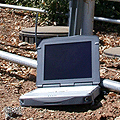

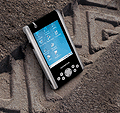
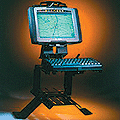





 This is made possible by a combination of rugged, compact computing equipment that can handle the punishment of vehicular use; integration with GPS functionality that enables location-based services; and increasing integration of computers into the vehicle itself. But how does it all work?
This is made possible by a combination of rugged, compact computing equipment that can handle the punishment of vehicular use; integration with GPS functionality that enables location-based services; and increasing integration of computers into the vehicle itself. But how does it all work?

 And while most TREK-303 displays will be mounted inside vehicles away from rain or splashing, the TREK-303 does carry an IP43 rating (protected against solids larger than 1 mm in diameter and against water spray to the front) for the whole device, with everything but the I/O ports actually sealed to IP54 standards (protected against dust and also against water spray from all directions). The unit has also been vibration-tested in accordance with MIL-STD-810G, SAE J1455 4.9.4.2.
And while most TREK-303 displays will be mounted inside vehicles away from rain or splashing, the TREK-303 does carry an IP43 rating (protected against solids larger than 1 mm in diameter and against water spray to the front) for the whole device, with everything but the I/O ports actually sealed to IP54 standards (protected against dust and also against water spray from all directions). The unit has also been vibration-tested in accordance with MIL-STD-810G, SAE J1455 4.9.4.2.


 It is hard to overestimate the potential benefit of mobile resource management. Intelligent fleet monitoring can revolutionize the way a business is run. In addition to basics like theft protection, dispatchers and fleet management know at any time where their vehicles are, what routes they have run, what the odometer reading is, and whether they are being used according to plan and policy.
It is hard to overestimate the potential benefit of mobile resource management. Intelligent fleet monitoring can revolutionize the way a business is run. In addition to basics like theft protection, dispatchers and fleet management know at any time where their vehicles are, what routes they have run, what the odometer reading is, and whether they are being used according to plan and policy.